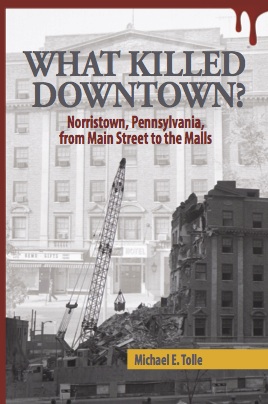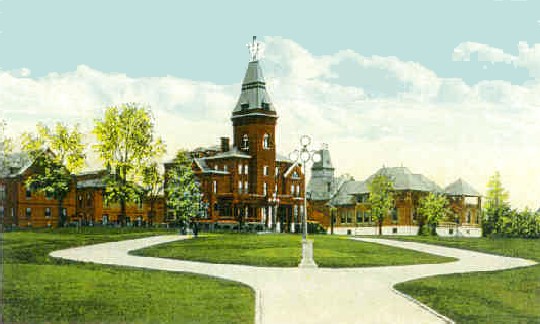At one time, downtown was the height of modernity. Now, in many cities, it’s gone. Detroit is only the beginning.
Watch old movies and TV shows and you’ll often see a thriving downtown. It was usually six or seven blocks of cheerful shopping, eating, and people watching. Although many cities have rebirthed their downtowns to great effect, most of them lie in sad ruins.
The culprits are obvious: the migration to the suburbs, the rise of the automobile and the shopping mall, and if you want to get really contemporary, the rise of e-commerce. However, there are forces much greater than these that get the root of the murder.
Historian Michael Tolle takes this dilemma and dissects it, with Norristown, PA as Exhibit A. His book, What Killed Downtown? ponders the very question, and why the answers don’t come as easily as we think – or want.
With Detroit lying in ruins, and other cities on the brink of bankruptcy and oblivion, the death of downtown is a topic that needs to remain on Main Street.
 Here, our interview with Michael whets our appetite.
Here, our interview with Michael whets our appetite.
What does Norristown mean to you?
People I knew would tell me about the Norristown of old. It was a classic American downtown. You can go there for just about any reason. And it had been that for well over a century.
By the time I got to the area, which was in the mid-1970s, it was already in serious decline and it has not come back. It remains a very troubled municipality.
I felt that the story of Norristown would be relevant to a great many other localities. And I believe that the story of downtown Norristown is the story of downtown America.
What made the American downtown initially successful?
Shopping is what constituted the downtown of America that we no longer see today. It was very interdependent. The shopkeepers not only owned the businesses, they may have owned the buildings. You can go to retail department stores and [smaller] retail stores, a doctor, a dentist, a movie, all along the same six blocks of downtown.
Was Norristown’s decline unique?
Norristown was by no means the only town to go undergo [decline] after the Second World War. This happened literally across the nation.
In most cases, what we find are what we call ‘the usual suspects:’ a town that may have been a company town, for example, or a town that may have been an industry town, steel being the most prominent. The town would suffer when the industry fell [or the company failed or moved away].
When I looked through these various usual suspects, I realized that none of them applied to Norristown…with one exception: the shopping mall.
You are referring to the mammoth King of Prussia Mall, which is nearby and one of the largest malls in the world.
Yes, the shopping mall – specifically The King of Prussia Mall –had grown and is still growing and is one of the great success stories.
I began to realize that the problem runs much deeper than the mall itself.
How is that?
In many cases, the buildings [in downtown Norristown] were owned by the businesses themselves, which, being small businesses, did not have the financial wherewithal to repair them or to simply hold on to them. Many were simply abandoned. There were also a number of purchases that took place and also fires of suspicious origin.
Was there any interest in historic preservation, which is a common concern today?
At the time, there is little mention of historic preservation. The focus of my book is between 1950 and 1975. What happens after that is not covered in the book itself.
By 1975, when my book concludes, I pronounce downtown Norristown dead. What it looks like is very much like Dresden [Germany] of the old days [post World War II].
So the question is not “why did Norristown decline?” but “why hasn’t it come back?”
This is the big question. It’s not just why it has collapsed, but why it has not come back.
This much we know: malls and cars have killed downtown. But the rest remains a mystery.
The roots of the mall go back to 1950, when I open the book.
Prior to 1950, King of Prussia was a very quiet, bucolic countryside.
The Pennsylvania Turnpike arrived in the fall of 1950. The origin of the mall itself is what we call the ‘triumph of the automobile,’ in the period after the Second World War.
It formerly opened in 1963, but stores were open prior to that. It has gone from success to success with its expansions. Another mall – not as well known – called The Plymouth Meeting Mall [opened as well].
Norristown was caught between these two areas, and was not directly connected to either one of them. The malls grow, administering the fatal blow to downtown Norristown.
Yet the Norristown downtown was dying prior to the mall openings.
The condition of downtown Norristown, Main Street, had been in accelerated decline for several years prior to the mall even opening.
You realize that the mall did not kill downtown. It merely hastened its death. King of Prussia was designed for the automobile; Norristown is a railroad town and is not well connected to the automobile network.
How curious: Norristown is no Dresden. It’s somehow retained its population despite the death of downtown.
The thing to keep in mind is that Norristown has not become depopulated. The population is a little bit lower than it was in its prime, but there are people still there. There isn’t that abandoned feeling.
Check out this important book here .
.

